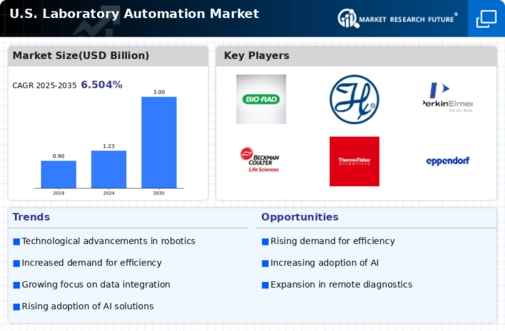The U.S. Laboratory Automation Market is characterized by rapid advancements in technology and increasing demand for efficiency in laboratory operations. As laboratories strive to enhance productivity and reduce human error, automation tools such as robotic systems, automated liquid handlers, and sample management systems have become indispensable. The competitive landscape is defined by a mix of established players and emerging companies that are continuously innovating to meet the evolving needs of the healthcare, pharmaceutical, and academic sectors. This market is influenced by varying factors such as regulatory standards, budgetary constraints, and the pace of technological adoption.
Key trends include the integration of artificial intelligence in laboratory automation systems and the growing preference for modular automation solutions that offer flexibility and scalability.
Danaher Corporation has a prominent position in the U.S. Laboratory Automation Market, bolstered by its strong portfolio of advanced analytical and automation instruments. The company's commitment to innovation is reflected in its continuous investment in research and development, which positions it favorably against its competitors. Danaher's strengths lie in its comprehensive range of products that cater to diverse laboratory needs, including high-throughput screening systems and digital workflow solutions.
With a well-established distribution network, the company ensures effective market penetration across different segments. Furthermore, Danaher's strategic partnerships and collaborations enhance its ability to deliver integrated solutions that significantly improve laboratory workflows in the U.S.
BioRad Laboratories also holds a significant share in the U.S. Laboratory Automation Market, offering a variety of products that are key to laboratory automation, such as liquid handling robots, assay kits, and diagnostic products. Known for its commitment to high-performance solutions, BioRad has developed advanced automated systems tailored for specific applications in clinical diagnostics and life sciences research. The company's strengths include its robust product development capabilities and strong customer relationships, which have led to loyalty and trust among laboratory professionals.
BioRad has also engaged in strategic mergers and acquisitions to expand its technological capabilities and market reach, ensuring it remains competitive in an evolving landscape. The company continues to focus on enhancing its service offerings, which positions it as a reliable partner for laboratories seeking to automate and optimize their processes in the United States.


















Leave a Comment